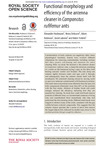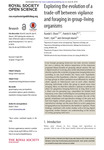Search
Now showing items 31-40 of 109
High atmospheric temperatures and ‘ambient incubation’ drive embryonic development and lead to earlier hatching in a passerine bird
(The Royal Society, 2016)
Tropical and subtropical species typically experience relatively high atmospheric temperatures during reproduction, and are subject to climate-related challenges that are largely unexplored, relative to more extensive work ...
Males migrate farther than females in a differential migrant: an examination of the fasting endurance hypothesis
(The Royal Society, 2014)
Patterns of migration including connectivity between breeding and non-breeding populations and intraspecific variation in the distance travelled are important to study because they can affect individual fitness and population ...
Tiarajudens eccentricus and Anomocephalus africanus, two bizarre anomodonts (Synapsida, Therapsida) with dental occlusion from the Permian of Gondwana
(The Royal Society, 2015)
Anomodontia was a highly successful tetrapod clade during the Permian and the Triassic. New morphological information regarding two bizarre basal anomodonts is provided and their palaeoecological significance is explored. ...
Functional morphology and efficiency of the antenna cleaner in Camponotus rufifemurants
(The Royal Society, 2015)
Contamination of body surfaces can negatively affect many physiological functions. Insects have evolved different adaptations for removing contamination, including surfaces that allow passive self-cleaning and structures ...
Sexual reproduction with variablemating systems can resist asexuality in a rock–paper–scissors dynamics
(The Royal Society, 2015)
While sex can be advantageous for a lineage in the long term, we still lack an explanation for its maintenance with the twofold cost per generation. Here we model an infinite diploid population where two autosomal loci ...
Endocranial and masticatory muscle volumes in myostatin-deficient mice
(The Royal Society, 2014)
Structural and functional trade-offs are integral to the evolution of the mammalian skull and its development. This paper examines the potential for enlargement of the masticatory musculature to limit the size of the ...
Female signalling tomale song in the domestic canary, serinus canaria
(The Royal Society, 2015)
Most studies on sexual selection focus on male characteristics such as male song in songbirds. Yet female vocalizations in songbirds are growing in interest among behavioural and evolutionary biologists because these ...
Exploring the evolution of a trade off between vigilance and foraging in group living organisms
(The Royal Society, 2015)
Even though grouping behaviour has been actively studied for over a century, the relative importance of the numerous proposed fitness benefits of grouping remain unclear. We use a digital model of evolving prey under ...
Eye spots in Lepidoptera attract attention in humans
(The Royal Society, 2015)
Many prey species exhibit defensive traits to decrease their chances of predation. Conspicuous eye-spots, concentric rings of contrasting colours, are one type of defensive trait that some species exhibit to deter predators. ...
Position dependent hearing in three species of bushcrickets
(The Royal Society, 2015)
A primary task of auditory systems is the localization of sound sources in space. Sound source localization in azimuth is usually based on temporal or intensity differences of sounds between the bilaterally arranged ears. ...










